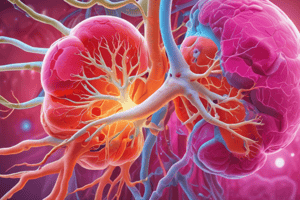Podcast
Questions and Answers
Where do hormones travel to reach their target cells or tissues?
Where do hormones travel to reach their target cells or tissues?
- Nervous system
- Endocrine system
- Lymphatic system
- Bloodstream (correct)
Which gland is not a part of the endocrine system?
Which gland is not a part of the endocrine system?
- Thyroid gland
- Adrenal glands
- Thymus gland (correct)
- Pituitary gland
What type of hormones are synthesized from cholesterol?
What type of hormones are synthesized from cholesterol?
- Growth hormones
- Steroid hormones (correct)
- Non-steroid hormones
- Adrenal hormones
Which type of hormones have a hydrophilic nature and are often released into the bloodstream in a bound form?
Which type of hormones have a hydrophilic nature and are often released into the bloodstream in a bound form?
What type of mechanism ensures that hormone levels remain within a narrow range?
What type of mechanism ensures that hormone levels remain within a narrow range?
Which type of feedback involves the production of a hormone being regulated in response to the hormone's level in the bloodstream?
Which type of feedback involves the production of a hormone being regulated in response to the hormone's level in the bloodstream?
What triggers the release of oxytocin in the positive feedback mechanism?
What triggers the release of oxytocin in the positive feedback mechanism?
Which gland stimulates the thyroid gland to produce thyroid hormones?
Which gland stimulates the thyroid gland to produce thyroid hormones?
What hormone does the hypothalamus release to stimulate TSH production?
What hormone does the hypothalamus release to stimulate TSH production?
What aspect of the endocrine system ensures that our bodies function optimally and remain in a state of homeostasis?
What aspect of the endocrine system ensures that our bodies function optimally and remain in a state of homeostasis?
Flashcards are hidden until you start studying
Study Notes
Understanding the Endocrine System: A Deep Dive into Glands, Hormones, and Homeostasis
The endocrine system, often referred to as the body's "chemical messenger" system, plays a critical role in maintaining homeostasis, or the stable internal environment necessary for optimal health. In this article, we'll explore the endocrine glands, their hormones, and the feedback mechanisms that regulate their function.
Endocrine Glands
The endocrine system comprises a collection of glands, each producing and secreting hormones. These hormones act as chemical signals, traveling via the bloodstream to their target cells or tissues. Some of the major glands in the endocrine system include:
- Pituitary gland
- Thyroid gland
- Parathyroid glands
- Adrenal glands
- Pancreas (endocrine portion)
- Gonads (testes and ovaries)
- Hypothalamus (a part of the brain)
Hormones
Hormones are molecules that are produced in limited quantities, ensuring that their effects are specific and targeted. They can be classified into two major types:
- Steroid hormones: These hormones are synthesized from cholesterol and have a hydrophobic nature. Examples include testosterone, estrogen, and cortisol.
- Non-steroid hormones: These hormones are derived from amino acids and have a hydrophilic nature. They are often released into the bloodstream in a bound form, which is then converted to an active form by enzymes. Examples include growth hormone (GH) and thyroid-stimulating hormone (TSH).
Feedback Mechanisms
The endocrine system is regulated by complex feedback mechanisms, ensuring that hormone levels remain within a narrow range to maintain homeostasis. These mechanisms include:
1. Negative feedback
In negative feedback, the production of a hormone is regulated in response to the hormone's level in the bloodstream. For example, when blood sugar levels are high, the pancreas releases insulin, which lowers blood sugar levels, and when blood sugar levels are low, the pancreas releases glucagon, which raises blood sugar levels.
2. Positive feedback
In positive feedback, the production of a hormone is stimulated by the hormone itself. For example, the hormone oxytocin is released in response to the uterine contractions during labor. Oxytocin then stimulates the production of more oxytocin, leading to a cascade of contractions.
3. Hormonal interplay
The endocrine system functions as a complex network, with hormones interacting in various ways. For example, TSH from the pituitary gland stimulates the thyroid gland to produce thyroid hormones, and the hypothalamus releases thyroid-releasing hormone (TRH) to stimulate TSH production.
The endocrine system is an intricate and fascinating part of the human body. Its glands, hormones, and feedback mechanisms work together to ensure that our bodies function optimally and remain in a state of homeostasis. By understanding the endocrine system, we gain a deep appreciation for the complexity and interconnectedness of our bodies.
Studying That Suits You
Use AI to generate personalized quizzes and flashcards to suit your learning preferences.




